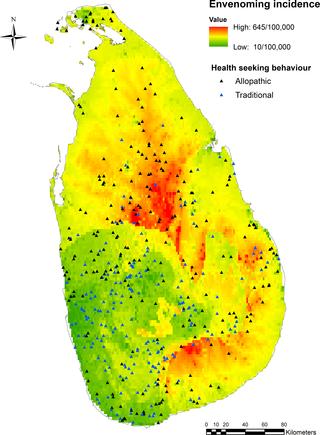PLOS Neglected Tropical Diseases ( IF 3.4 ) Pub Date : 2017-11-06 , DOI: 10.1371/journal.pntd.0006073 Dileepa Senajith Ediriweera , Anuradhani Kasturiratne , Arunasalam Pathmeswaran , Nipul Kithsiri Gunawardena , Shaluka Francis Jayamanne , David Griffith Lalloo , Hithanadura Janaka de Silva

|
Introduction
Sri Lanka has a population of 21 million and about 80,000 snakebites occur annually. However, there are limited data on health seeking behavior following bites. We investigated the effects of snakebite and envenoming on health seeking behavior in Sri Lanka.
Methods
In a community-based island-wide survey conducted in Sri Lanka 44,136 households were sampled using a multistage cluster sampling method. An individual who reported experiencing a snakebite within the preceding 12 months was considered a case. An interviewer-administered questionnaire was used to obtain details of the bite and health seeking behavior among cases.
Results
Among 165,665 individuals surveyed, there were 695 snakebite victims. 682 (98.1%) had sought health care after the bite; 381 (54.8%) sought allopathic treatment and 301 (43.3%) sought traditional treatment. 323 (46.5%) had evidence of probable envenoming, among them 227 (70.3%) sought allopathic treatment, 94 (29.1%) sought traditional treatment and 2 did not seek treatment. There was wide geographic variation in the proportion of seeking allopathic treatment from <20% in the Western province to > 90% in the Northern province. Multiple logistic regression analysis showed that seeking allopathic treatment was independently associated with being systemically envenomed (Odds Ratio = 1.99, 95% CI: 1.36–2.90, P < 0.001), distance to the healthcare facility (OR = 1.13 per kilometer, 95% CI: 1.09 to 1.17, P < 0.001), time duration from the bite (OR = 0.49 per day, 95% CI: 0.29–0.74, P = 0.002), and the local incidence of envenoming (OR = 1.31 for each 50 per 100,000, 95% CI: 1.19–1.46, P < 0.001) and snakebite (OR = 0.90 for each 50 per 100,000, 95% CI: 0.85–0.94, P < 0.001) in the relevant geographic area.
Conclusions
In Sri Lanka, both allopathic and traditional treatments are sought following snakebite. The presence of probable envenoming was a major contribution to seeking allopathic treatment.
中文翻译:

斯里兰卡被蛇咬后寻求健康的行为:全岛基于社区的调查结果
介绍
斯里兰卡人口为2100万,每年约有80,000次蛇咬。但是,关于叮咬后寻求健康行为的数据有限。我们调查了蛇咬和蛇毒对斯里兰卡寻求健康行为的影响。
方法
在斯里兰卡进行的一项基于社区的全岛调查中,使用多阶段整群抽样方法对44136户家庭进行了抽样。报告在过去12个月内经历过蛇咬伤的个人被视为病例。由访调员管理的调查表用于获取病例之间的咬伤和寻求健康行为的详细信息。
结果
在接受调查的165,665个人中,有695人被蛇咬。咬伤后有682(98.1%)人寻求医疗护理;381(54.8%)人寻求同种疗法,301(43.3%)人寻求传统疗法。323例(46.5%)有可能被毒化,其中227例(70.3%)寻求同种疗法,94例(29.1%)寻求传统疗法,2例未寻求治疗。寻求同种疗法的比例存在很大的地域差异,从西部省的<20%到北部省的> 90%。多元logistic回归分析显示,寻求同种疗法与全身被毒有关(赔率= 1.99,95%CI:1.36–2.90,P <0.001),距医疗机构的距离(OR = 1.13每公里,95%CI :1.09至1.17,P <0.001),
结论
在斯里兰卡,蛇咬后寻求同种疗法和传统疗法。可能的毒液的存在是寻求同种疗法的主要贡献。











































 京公网安备 11010802027423号
京公网安备 11010802027423号